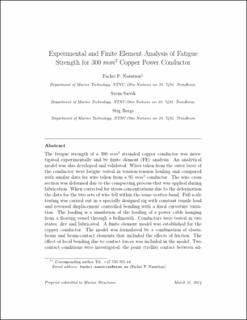| dc.contributor.author | Nasution, Fachri Panusunan | |
| dc.contributor.author | Sævik, Svein | |
| dc.contributor.author | Berge, Stig | |
| dc.date.accessioned | 2024-03-20T12:10:22Z | |
| dc.date.available | 2024-03-20T12:10:22Z | |
| dc.date.created | 2014-09-01T09:04:57Z | |
| dc.date.issued | 2014 | |
| dc.identifier.citation | Marine Structures. 2014, 39 225-254. | en_US |
| dc.identifier.issn | 0951-8339 | |
| dc.identifier.uri | https://hdl.handle.net/11250/3123383 | |
| dc.description.abstract | The fatigue strength of a 300 mm2 stranded copper conductor was investigated experimentally and by finite element (FE) analysis. An analytical model was also developed and validated. Wires taken from the outer layer of the conductor were fatigue tested in tension–tension loading and compared with similar data for wires taken from a 95 mm2 conductor. The wire cross section was deformed due to the compacting process that was applied during fabrication. When corrected for stress concentrations due to the deformation the data for the two sets of wire fell within the same scatter-band. Full scale testing was carried out in a specially designed rig with constant tensile load and reversed displacement controlled bending with a fixed curvature variation. The loading is a simulation of the loading of a power cable hanging from a floating vessel through a bellmouth. Conductors were tested in two states; dry and lubricated. A finite element model was established for the copper conductor. The model was formulated by a combination of elastic beam and beam-contact elements that included the effects of friction. The effect of local bending due to contact forces was included in the model. Two contact conditions were investigated; the point (trellis) contact between adjacent layers of wire and the inline contact within each layer and between the first layer (centre wire) and the second layer. The FE model was validated by a calibration test of a full scale conductor, and by sensitivity studies varying the size and the number of elements of the model. Fatigue analysis of the conductor was carried out, based on the S–N curve for individual wires. Taking into account the effects of friction and local bending, agreement was obtained between predicted and experimental fatigue strength of the conductor, for the FE model as well as the analytical model. | en_US |
| dc.language.iso | eng | en_US |
| dc.publisher | Elsevier | en_US |
| dc.title | Experimental and finite element analysis of fatigue strength for 300 mm2 copper power conductor | en_US |
| dc.title.alternative | Experimental and finite element analysis of fatigue strength for 300 mm2 copper power conductor | en_US |
| dc.type | Journal article | en_US |
| dc.type | Peer reviewed | en_US |
| dc.description.version | submittedVersion | en_US |
| dc.source.pagenumber | 225-254 | en_US |
| dc.source.volume | 39 | en_US |
| dc.source.journal | Marine Structures | en_US |
| dc.identifier.doi | 10.1016/j.marstruc.2014.07.005 | |
| dc.identifier.cristin | 1150622 | |
| cristin.ispublished | true | |
| cristin.fulltext | preprint | |
| cristin.qualitycode | 2 | |
